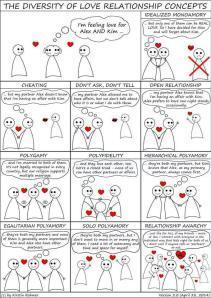Applying the concept of openness to all relationships in various ways.
Content warning: relationship conflict and abusive relationships are touched on briefly in this post.
A decade ago I started studying three topics that have pretty much defined my career: open non-monogamy, BDSM, and bisexuality. I just checked my CV and found that my first academic publication in these areas came out in 2004: an interview with the ever-fabulous Jen Yockney of Bi Community News for the Lesbian and Gay Psychology Review (now appropriately renamed the Psychology of Sexualities Review). That was quickly followed by an interview, in the same publication, with the equally wonderful Dossie Easton, about her writing on kink and polyamory.

Me and Jen Yockney more recently
It’d taken me six years since finishing my PhD to start researching these topics. My first paper based on my PhD (on a different topic) had been rejected with cruel comments from one reviewer. So I decided that academic research wasn’t for me and to focus on teaching, which I really enjoyed. I still have major issues with that side of academia. But then I started to read about gender and sexuality for my teaching, and to attend more interdisciplinary conferences. I realised that it was possible – perhaps even beneficial – to research topics that were personally relevant.
Although I can’t say that this guiding principle has made for a completely easy ride (to say the least!), I have learnt a huge amount from researching polyamorous, BDSM, and bi communities. My work has always been led by the question of what we (i.e. everybody) can learn from such communities, rather than the more traditional psychological question of how they can be explained. The answers I’ve explored have focused on the benefits of more open approaches to relationships rules around monogamy, the consensual arrangements that kinky folk use in their sexual activities, and non-binary understandings of sexual attraction (i.e. not just attraction to either ‘the same’ or ‘the opposite’ gender).
Recently I’ve been reflecting on the directions that my thinking about relationships has been taking in the last few years. I realised that these themes of openness, consent, and non-binary are still very present, but in different forms. Previously I’d just thought of openness in the context of non-monogamy, consent in the context of (kinky) sex, and non-binary in the context of sexuality.
I thought I’d write a couple of blog posts to explain the ways in which my thinking has expanded out lately, considering the benefits of applying openness and consent to our relationships in a much broader way. Regarding non-binary I have a much longer piece of writing bubbling away about what happens when we apply this concept beyond sexuality and gender to our ways of relating, feeling, and thinking.
I’ll spend the rest of this post on openness.
Open non-monogamy
Probably the first revelation in my explorations of open non-monogamy was the fact that it was possible at all. Wider culture presents long term monogamy as the only way of doing relationships, with non-monogamy only being possible in the form of cheating, which will inevitably mean the end of the relationship.
I found that various forms of swinging and open relationships offer the possibility of couples having additional sexual relationships in an honest and open way. Primary/secondary polyamorous couples show that it is also possible to have love relationships outside a primary couple.
I also found that polyamory opens up the possibility of relationships beyond this conventional couple-based model. There are Vs, triads and quads, poly families and networks, and all kinds of other ways of managing multiple love relationships. This offers an alternative to the conventional model of putting The One partner or spouse way at the top of a hierarchy of important relationships, with all of the high expectations this places on that relationship.

The diversity of love relationship concepts, by Kirstin Rohwer
However, as I explored these things myself and talked with colleagues about it, one thing that became apparent was that many of these models still generally place romantic, or sexual, partnerships as more important than other kinds of relationships. In fact there can be a risk that the division between partners and friends becomes even larger when we have more partners, and perhaps even less time or energy for friends, or for other kinds of relationships including our relationship with ourselves.
Another thing which I recognised in myself and others was that it becomes possible in open non-monogamy to replace a search for The One perfect partner with a search for the perfect relationship style which will solve all the problems inherent in close relationships and/or mean that you are constantly bathed in the reassurance and validation of multiple adoring gazes.
Neither of these issues is a reason to reject open non-monogamy in favour of a return to monogamy. It’s not an all-or-nothing situation where we can find one universally ‘right’ way of doing relationships and dismiss all the others. Rather I concluded that we need to embrace the diversity of possible relationship structures: versions of singledom, coupledom and polyamory; monogamies and non-monogamies and all the possibilities in between; friends-based, family-based, and partner-based models; and anything else that people are doing. Along with this it’s important to recognize that different things work for different people and at different times in their lives.
It ain’t what you do it’s the way that you do it
So that is probably about where I got to in the monogamy chapter of Rewriting the Rules and the other writing I was doing about open non-monogamy around that time.
Since then I’ve increasingly recognised how – in many areas – it seems like we get so focused on what people do that we pay much less attention to how they are doing it. I’ve started to wonder if the latter question might actually be the more useful one.
For example, this year I’ve been analysing sex advice books (more blog posts on that topic will doubtless be arriving soon!) It took me a while to realize one of the major problems with them: they were all about what people do sexually rather than how they do it. So all the advice was about trying different positions or ‘spicing things up’ with toys or techniques. There was much less on what I would see as the more important matters of how you figure out what you like, how you communicate that to others, how you ensure consent, how you learn about different bodies, and lots of other kinds of how. In the book that Justin Hancock and I are writing on this topic one thing that we’ve already decided is that the focus will be much more on the how.
Going back to relationships I think a lot can be gained from a more how-based approach. As I said I’m increasingly convinced that issue of what people do, in terms of structuring their relationships, is rather less important than how they relate within them. Both academic research and media on these topics often gets obsessed with the what: Look at those crazy polyamorists, or swingers, or whatever! Instead perhaps it’d be more valuable to look across all different kinds of relationships to explore how people do their relationships in ways that work well, or not so well, for them.
This brings me back to openness because I think that is a key part of this how. I’m going to touch on three ways in which we might consider the openness of our relationships which go beyond whether they are monogamous or not, and could apply just as much to monogamous as non-monogamous relationships. These are:
• Being open to vulnerability,
• Opening the windows on our relationships, and
• Opening up our possibilities.
Open to vulnerability
The research on conflict suggests that we tend to respond in two ways when there is conflict in our relationships. We tend to withdraw, or we tend to attack. Withdrawing includes all of the different ways of putting up defences to protect ourselves. Attacking includes all of the different ways of projecting the conflict outwards, onto the other person, instead of accepting any responsibility ourselves.
Strong versions of withdrawal would include things like storming out, or completely shutting down. Weaker versions would include shifting the conversation to avoid the topic, subtly putting up our defences so the other person can’t get in, or distancing from a relationship without letting the other person know there’s a problem.
Strong version of attacking would include hurling abuse and insults, or physical attack. Weaker versions would include sharply dismissing another point of view, niggling and nagging at the other person to let them know about aspects of them that you don’t think are okay, jokey putdowns, or complaining about them to other people.
Both of these strategies of withdrawal and attack are ways of protecting ourselves where we’re vulnerable. Think about conflicts you’ve had. They only tend to happen when someone has triggered something you feel vulnerable about –whether you’re consciously aware of that at the time or not. If that triggering doesn’t happen then it isn’t really a conflict. It’s just one person having a go and another person finding it easy to empathise with them and/or to step away kindly.
A – very challenging – alternative to withdrawal or attack in situations where we’ve been triggered is openness. This involves staying open to the vulnerability that we are feeling rather than putting up our defences, or attacking or projecting blame, in attempts to protect ourselves.
Another part of this is being open to the vulnerability in others: recognising that their withdrawal and/or attack likely stems from their own vulnerability. This is perhaps an even greater challenge as it involves being open and compassionate to others at the very moment that they are being most difficult or threatening to us: hard to empathise with or to feel love for.
Whether with ourselves or with others, such openness involves staying with the situation rather than attempting to shut it down; taking the the time to notice what is going on (which will likely involve taking some time out before returning to it); recognising that there is a sensible reason for the seemingly inexplicable behavior of the other person or ourselves; and going slowly and gently enough to find it (or trusting that it is there if it doesn’t easily reveal itself). It also involves the openness to let the other person know about our vulnerability, or to listen to theirs in the vulnerable situation of realising that we are the one who triggered it.
This form of openness is clearly applicable to all relationships, not just partner ones. Although it may be the relationships that we spend most time in, and that we are most highly invested in, that challenge us the most because it is much less easy to simply withdraw from them.
Opening the windows on our relationships
One question that you might well have had reading the previous section is about abusive dynamics. The idea of being open to our vulnerability, and to the vulnerability of others, is certainly a challenging one to apply to situations when one person is consistently physically or emotionally attacking the other. This is something I’ll return to in the next post on consent.
Another important aspect of openness occurs to me when thinking about abusive relationships. something that we know from the research on domestic abuse is that abusers tend to isolate their partners from friends and family, pressurising them into keeping aspects of the relationship secret. A particularly worrying thing about the popular Fifty Shades of Grey series is that Christian doesn’t allow Ana to talk about the kinky side of their relationship with anybody in her life.

Fifty Shades of Grey: Not the most open relationship
So another important aspect of openness in relationships could be how open they are to other people beyond the relationship itself. Perhaps it could be a warning bell in any relationship if we’re feeling that we have to keep elements of it private or secret, or that we are unable to talk about the difficult parts of the relationship with other people.
Recently I was in a pub conversation with somebody who was complaining about how badly their housemates were at doing the chores. She was in the process of moving out and her partner, who she was moving in with, nervously said that he hoped that she would be able to talk about the issue directly with him if it became an issue rather than discussing it with friends in the pub!
I take the partner’s point of course. Part of openness to vulnerability would, I hope, be that we could try to talk with each other directly when there is an issue. But I also found myself thinking that I would like it if my partner (or any other person in a relationship with me) felt able to chat to other close people about our issues. Of course it would feel vulnerable for me to know that this was happening, but actually I would prefer the safety of feeling that vulnerability whilst knowing that our relationship was getting fresh air through it in this way, to the more questionable safety of keeping our ‘dirty laundry’ to ourselves.
Abusive dynamics are not specific to physical violence. Nor are they specific to situations where just one person abuses another: it can be a lot more even between the people concerned too. And nor are they specific to partner relationships, as anybody who has ever been in an abusive friendship or a bullying situation at work will confirm.
Openness in the form of transparency, or letting others in, is therefore another aspect of open relationships that is well worth exploring for ourselves, and with the people we’re in relationships with, no matter what kind of relationship it is.
As I explored in the conflict chapter of Rewriting the Rules, the current cultural pressure is to present our relationships as perfect, and to never admit to any struggles. Bringing this kind of air and spaciousness to our relationships could be beneficial not only to us, but also to the people we open up to: because they won’t be able to use our supposedly ‘perfect’ relationship as an unrealistic point of comparison any more. Such openness more widely could also help us, as a culture, to recognize that relationships of all kinds can be tough, rather than suggesting that any one kind of relationship structure will really lead to ‘happy-ever-after’.
Opening up our possibilities?
So we’ve considered openness in the form of being open to vulnerability (our own, and others), and in the form of transparency in relationships. A final form that I thought of is whether any particular relationships opens up, or closes down, the possibilities of the people in it.
When I wrote the break-up chapter of Rewriting the Rules I realised that most of the chapter failed to address the most urgent question that most people have around break-up, which is how to know when they should break-up with someone. I struggled with providing advice about this because, of course, it is so specific to that person and their situation. One suggestion I did come up with was to think about whether it felt like the relationship was more opening up the possibilities of the people in it or more closing them down.
I still don’t want to do much more than put that idea out there as one to think about, perhaps not just at the end of the relationship but all the way through it, and in all kinds of relationships: parent/child, friends, siblings, colleagues, and neighbours, as well as partners.
Of course it is likely that there are all kinds of openings up and closings down going on constantly, but the different ways in which this is happening, and how that feels for us, seem like useful things to reflect on, ourselves and with the other person or people. This is another thing that will come up again in the next post on consent because it is definitely woven in with treating people consensually in relationships.
Concluding thoughts
Now that I come to the end of this long post (thank-you if you’ve made it all the way through!) I realize that this whole series could be titled ‘rewriting rewriting the rules’!
I guess it’s also part of this way of seeing these things to acknowledge the inevitable imperfection of any one thing that I write, and to try to be open and transparent about that. While I’m alive everything is a process: a work in progress. A blog is much better than a book at capturing that.
